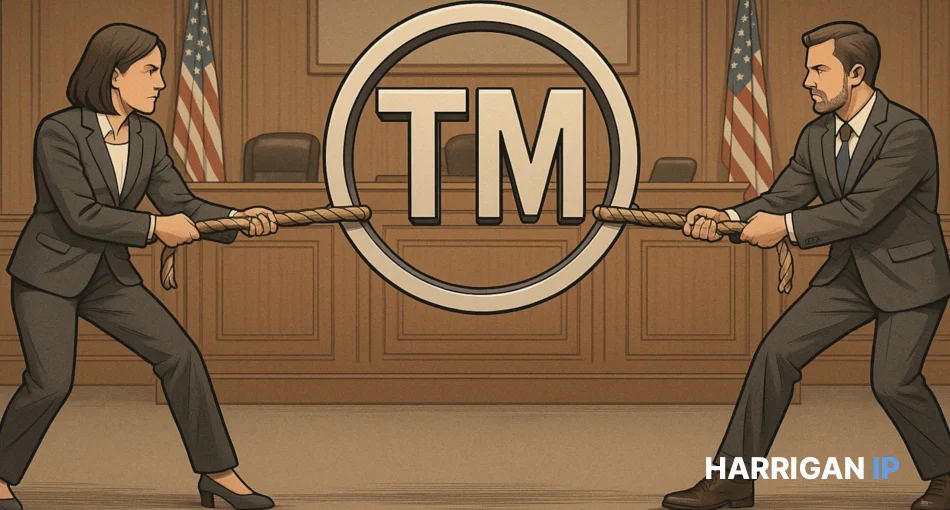These proceedings give others a chance to block your application—or let you block someone else’s. Understanding how they work, why oppositions happen, and how to respond is key to protecting your brand. And while this may sound procedural, make no mistake—TTAB proceedings can carry real legal consequences. If you lose, you may not get a second chance to register your brand.
Common Grounds for Opposition
A trademark opposition starts when someone challenges an application that the United States Patent and Trademark Office (USPTO) has preliminarily approved. The USPTO signals this approval by publishing the mark in the Official Gazette. Anyone who believes a mark could harm their brand has 30 days to file a Notice of Opposition.
The Trademark Trial and Appeal Board (TTAB) handles these proceedings. The TTAB reviews evidence and arguments from both the applicant and the opposer to decide whether the mark can register. While TTAB proceedings don’t result in monetary damages like a federal lawsuit, they can determine whether your application succeeds or fails—which can impact your entire branding strategy.
Oppositions often rely on one of the following grounds:
- Likelihood of Confusion: If a new mark might confuse consumers because it resembles an existing one, it could be opposed. For example, imagine launching “Starducks Coffee” and facing swift action from Starbucks. Learn more about trademark infringement and enforcement.
- Descriptiveness: If the mark merely describes the product or service, it lacks distinctiveness. For instance, “Cold Smoothies” as a name for a smoothie brand likely won’t fly. See our guide on choosing a strong trademark.
- Dilution: Famous brands can oppose marks that weaken their identity—even without confusion. Picture someone applying for “Apple Home Repair.” That brand might not sell iPhones, but Apple could still oppose it for diluting their famous name. Learn about trademark dilution.
- Genericness: Common terms like “Computer” for a computer brand won’t fly. They’re considered too generic to protect.
- Bad Faith: Some applicants register marks just to block others or piggyback on an existing brand. That’s a quick way to get opposed—and lose.
Should You Fight—or File—an Opposition?
Before jumping in, ask: Do I have a real chance of winning? Filing or defending an opposition involves risk, cost, and time. The opposer must prove their case by showing it’s more likely than not that the application should be denied. The applicant must then counter those claims effectively to move forward.
Unlike a cease and desist letter, a TTAB opposition is a formal legal proceeding. That means deadlines, evidentiary rules, and strategic filings—all of which are hard to manage without counsel. And while legal representation isn’t required, it’s rarely a good idea to go it alone.
Legal help here isn’t just helpful—it’s strategic. A smart approach from the beginning often saves time and money later.
Stages of a Trademark Opposition Proceeding
- Notice of Opposition: This kicks things off. The opposer files a document listing the grounds for opposition and the parties involved. It must be filed within 30 days of publication, with limited extensions available. Visit our Oppositions & Cancellations page for help.
- Answer: The applicant has 40 days to respond. If they don’t, they lose by default. This response is their chance to deny the claims and assert defenses. Even if the applicant believes the opposition is baseless, failing to respond means forfeiting the mark.
- Discovery: Both parties exchange information: written questions, documents, and depositions. This phase can uncover useful evidence—but it also creates traps. Want to know how to prep for this phase? Read our post on trademark coexistence and strategy.
- Trial Phase: This trial happens entirely in writing. Both parties submit briefs, declarations, and evidence. You won’t be arguing in a courtroom, but don’t underestimate the importance of strong legal writing, expert declarations, and admissible evidence.
- Decision: The TTAB reviews everything and issues a decision. Either side can appeal to a federal court. That decision could allow a registration to proceed—or kill a brand’s momentum before it starts.
How to Avoid Trademark Oppositions
You can’t avoid every conflict, but you can reduce your odds of getting opposed:
- Start with a Comprehensive Search: A clearance search reveals similar marks before you file. Many oppositions stem from conflicts that could’ve been avoided with a proper search up front.
- Pick a Distinctive Name: The more unique your name, the less likely someone will challenge it. Descriptive marks attract more scrutiny. Check out our guide to selecting strong trademarks.
- Get Legal Advice Early: Working with an attorney saves headaches later. We can spot red flags before you invest in branding. Start your application here: Register a Trademark.
Conclusion
Trademark oppositions can feel like roadblocks—but they’re also opportunities to protect what you’ve built. Whether you’re defending your application or stopping someone else’s, every step counts. Given the complexity of these proceedings and the potential consequences for both applicants and opposers, it is crucial to have experienced legal counsel on your side.
At Harrigan IP, we help small businesses fight—and win—trademark disputes. Contact us today to put experience on your side.
Related Resources:

